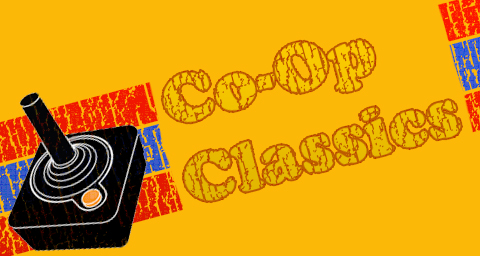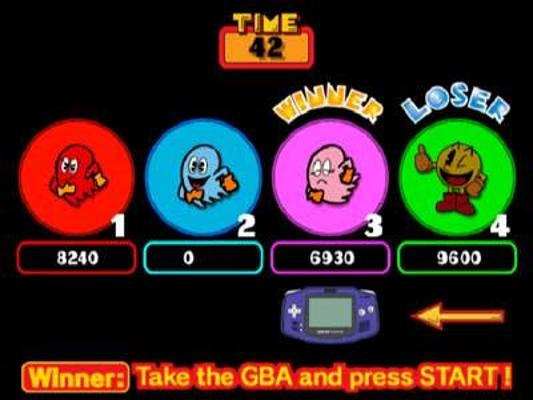

Pac-Man is the most popular video game character of all time. Mario and Master Chief are great, no doubt, but neither of them had a Top 40 pop hit, like Pac-Man did back in the day. Many game historians consider Pac-Man to be the most important video game of all time; considering the countless sequels and tie-in merchandise that has been produced over the past three decades, it's hard to argue otherwise. Today we'll take a look at two versions of Pac-Man that include a form of co-op gameplay.
Before we get too far into this discussion, let's take a look at the Official Co-Optimus Definition of Co-Op:
A co-op game is a game where two or more players work together to accomplish a goal against AI opponents. Ideally the game will feature a strong story in which both players take part of. Co-Op can be online over the internet, offline on the same console, or via a LAN or Wireless Network. We do not consider team based games as co-op where players face off against another team of human players.
For the purposes of this article, we are going to strike out a few choice bits of this definition. We don't normally ignore the rules, but given that Pac-Man is undeniably a classic video game, and today is in fact the 30th anniversary of the game's release, we'll make an exception. I'm guessing most of our readers are single player gamers, anyway, and likely have a fondness for Pac-Man.

The original Pac-Man, Ms. Pac-Man, and a whole host of other sequels were meant as single-player experiences. Though a two-player mode was included, it merely allowed friends to alternate turns. In late 2003, Pacman Vs. was released for the Nintendo Gamecube. It was a pack-in with a few Gamecube titles, most notably Pac-Man World 2. Designed by Mario creator Sigeru Miyamoto, Pacman Vs. offered a simultaneous multiplayer experience to Pac-fans for the first time. The game required the use of one Game Boy Advance handheld, connected to the Gamecube via a cable. (Only a few games used this GBA/GC connectivity, including Zelda Four Swords Adventures, which we covered previously.)
The classic Pac-Man gameplay formula was unchanged: Pac-Man ate dots for score, and power pellets allowed him to eat the ghosts that wandered the maze in search of him. In the original Pac-man, ghosts moved in predictable patterns that could be learned and avoided. Not so in Pac-Man Vs.! Instead, up to three human players controlled the ghosts in the maze, displayed on the TV screen and controlled with Gamecube controllers. Another human player controlled Pac-Man, using the linked Game Boy Advance. As you might imagine, avoiding human ghosts is far harder than even the trickiest computer controlled ghosts. In fact, the three to one advantage ghosts had over Pac-Man would be almost impossible to overcome, except for one fact: ghosts could see only a very limited portion of the overall maze on the TV screen.
It was here that the cooperative elements of PacMan Vs. really begin to shine. Ghost players had to coordinate efforts in order to overcome the Pac-Man controller's superior knowledge of the state of the maze, which displayed in full on the GBA screen. As you can see from the screenshots, the viewable area for ghosts was incredibly small, though a radar map in the corner did help somewhat. Another inclusion to help the ghosts was fruit, which greatly increased the view for any ghost who ate it. Players of ghosts would shout out Pac-Man sightings to each other, jealously guard power pills, and try all sorts of other strategies in order to catch Pac-Man. Once he was caught, the round was over, and the GBA was passed to the "catcher" to take a turn as the pellet gobbler. Playing Pac-Man this way was a frantic, fun-filled experience.
Pac-Man Vs. was a great game, but, because the GBA/GC link never really took off, many people never had the chance to play it. Swapping controllers was a bit of a pain, since the Game Boy Advance had to be tethered to the Gamecube at all times. Many of these issues became moot when Pac-Man Vs. was included in the Namco Museum compilation for the DS, alongside many other classics like Galaga and Xevious. One copy of the game was all that was required, thanks to the connectivity features of Nintendo's innovative handheld. Many long family trips in our car went by faster when we played a few rounds of Pac-Man Vs. together. Though not a true co-op game, there are certainly teamwork elements and a strong sense of working together for the ghosts, and it's hard for Pac-man to feel picked on or ganged up against when the roles change so quickly. In this sense, Pac-Man Vs. is quite cooperative.
A true co-op version of Pac-Man has been released, but only barely! Today, for the 30th anniversary of the game, Google changed it's logo to a fully playable version of Pac-Man. Geeks everywhere rejoiced at this news. Not only can you play a game of Pac-Man, in a Google-shaped maze, but if you click "Insert Coin" twice, Ms. Pacman shows up to play as well! Mr. Pac is controlled by the arrow keys, while the Ms. uses the WASD configuration. Have a friend, relative, or co-worker try it out with you. Or, if you are really hard-core, see if your left hand can co-op with your right. I tried to do it, and never even cleared the first maze. Kudos to Google for the inclusion of co-op in such a clever manner. Hopefully, a fancy new version of Pac-Man with this sort of authentic cooperative gameplay will be fully fleshed out in the future! We'll conclude this our celebration of Pac-Man's 30th birthday with this superlative quote from immortal songsmiths Buckner and Garcia:
Now I've got them on the run, and I'm looking for the high score;
So it's once around the block, And I'll slide back out the side door.
I'm really cookin' now, eating everything in sight.
All my money's gone, so I'll be back tomorow night.